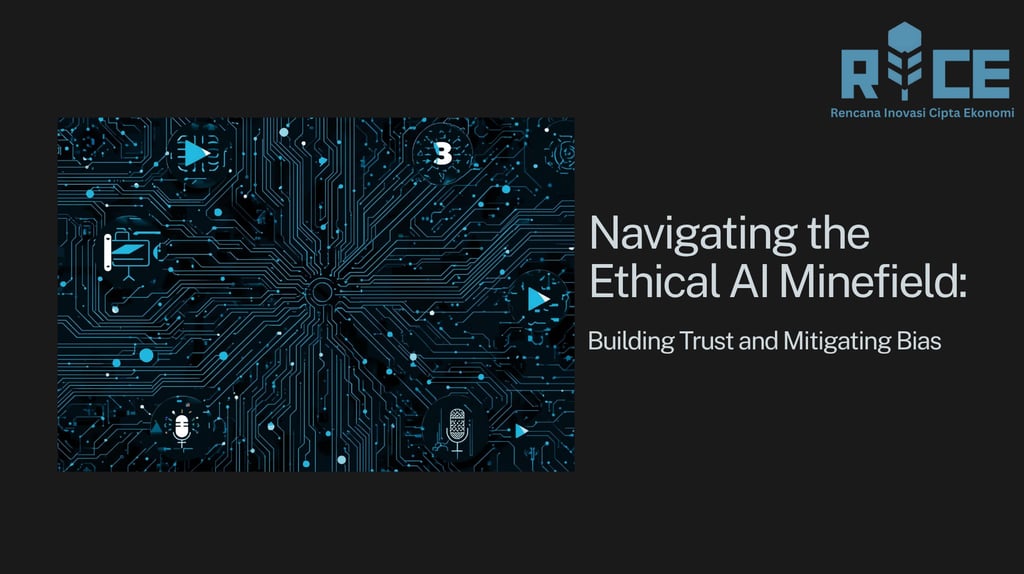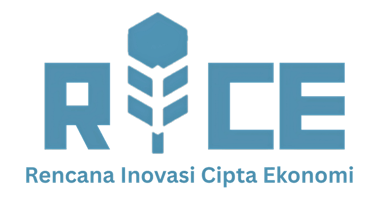Navigating the Ethical AI Minefield: Building Trust, Mitigating Bias, and Embracing Regulation in Telecom, Media & Entertainment
Explore the ethical AI challenges in Telecom, Media, & Entertainment: building trust, mitigating bias, and navigating regulation for responsible innovation.
INDUSTRIES
Rice AI (Ratna)
11/17/202510 min read


Imagine a world where the content you consume, the networks you rely on, and the entertainment you seek are all meticulously crafted and delivered by Artificial Intelligence. Now, imagine this sophisticated AI making decisions that, while efficient, carry unseen biases, erode trust, or operate in a regulatory vacuum. This isn't a dystopian fantasy; it's the complex reality facing the Telecom, Media, and Entertainment (TME) sectors today. The rapid deployment of AI promises unprecedented personalization and operational efficiency, yet it simultaneously presents a formidable ethical minefield.
For industry experts and professionals in TME, the challenge is clear: how do we harness AI's power while ensuring it aligns with societal values, respects individual rights, and maintains public trust? This isn't merely an academic exercise; it's a strategic imperative that will define industry leadership. Navigating this landscape requires a deep understanding of AI's ethical implications, a commitment to proactive bias mitigation, and a willingness to engage with the evolving regulatory frameworks. At Rice AI, we recognize these challenges and partner with organizations to build responsible AI solutions that foster innovation and uphold public confidence.
The Promise and Peril of AI in Telecom, Media & Entertainment
AI's transformative potential across TME sectors is undeniable, offering advancements that redefine how we connect, consume, and create. From hyper-personalized experiences to optimized infrastructure, the benefits are vast. Yet, these very capabilities also introduce complex ethical dilemmas that demand careful consideration and proactive management.
AI's Transformative Potential
In Telecom, AI is revolutionizing network management through predictive maintenance, optimizing resource allocation, and enhancing customer service with intelligent chatbots and personalized plan recommendations. This leads to more reliable services and tailored user experiences. For example, AI can predict network outages before they occur, allowing providers to address issues proactively.
The Media landscape is being reshaped by AI in content creation assistance, automated news summarization, and sophisticated recommendation engines that curate personalized feeds. AI also powers highly targeted advertising, connecting consumers with relevant products and services more efficiently. (Internal link suggestion: "Deep Dive: How AI is Reshaping Media Consumption")
In Entertainment, AI contributes to everything from virtual production and special effects to interactive storytelling and hyper-realistic digital avatars (deepfakes). It also aids in content localization and distribution, making entertainment more accessible globally. These innovations offer immersive experiences, but their ethical implications are significant.
Why Ethical Concerns are Amplified in TME
The TME sectors hold a unique position due to their direct and pervasive impact on public perception, information dissemination, and cultural narratives. AI applications in these areas touch fundamental aspects of daily life, influencing opinions, shaping consumer behavior, and potentially impacting democratic processes. The data-intensive nature of TME operations often involves collecting and processing vast amounts of sensitive user data, from viewing habits to communication patterns. This raises critical questions about data privacy, security, and consent.
Furthermore, the potential for AI-driven systems to manipulate information, create echo chambers, or facilitate discrimination at scale is a significant concern. When AI determines what news you see or what content you're recommended, its inherent biases can have far-reaching societal consequences. Understanding these amplifications is the first step toward building truly responsible AI.
The Trust Imperative: Erosion and Reconstruction
In the digital age, trust is the ultimate currency. For TME companies, maintaining consumer trust is paramount, especially as AI becomes more integrated into core services. The opaque nature of many AI systems can quickly erode this trust if ethical principles are not embedded from the outset.
Understanding AI Trust
Building and sustaining AI trust hinges on several key pillars. Transparency dictates that users should understand how AI decisions are made and what data is being used to inform those decisions. This doesn't necessarily mean revealing proprietary algorithms but rather clear communication about AI's role and function. Fairness ensures equitable treatment, meaning AI systems should not discriminate against individuals or groups based on protected characteristics. This principle is vital for maintaining social equity.
Accountability establishes clear responsibility for AI outcomes, ensuring that when an AI system makes an error or causes harm, there is a clear path for redress and correction. Without accountability, trust cannot be sustained. Finally, Explainability (XAI) focuses on making AI models understandable to humans, particularly regarding their reasoning processes. While full explainability can be challenging for complex models, striving for interpretability is crucial for audits and user confidence.
Case Studies of Trust Erosion (Hypothetical Scenarios)
Consider a scenario where a telecom company uses an AI system for credit scoring or service eligibility, and its algorithms, trained on historical data, unfairly penalize certain demographic groups. Customers from these groups might consistently be denied premium services or offered less favorable terms, leading to widespread distrust and potential legal challenges. The lack of transparency in such decisions only exacerbates the problem.
In the media sector, an AI-powered content recommendation algorithm, designed to maximize engagement, might inadvertently promote divisive or polarizing content. By creating algorithmic echo chambers, the system could contribute to social fragmentation and a lack of exposure to diverse viewpoints, ultimately eroding public trust in the media outlet's impartiality. Users might feel manipulated or perceive the platform as biased.
An entertainment platform that extensively uses AI to generate content, such as voiceovers or character designs, without clearly disclosing the AI's involvement could face a backlash. If consumers discover that content they believed was human-created was actually AI-generated, it could lead to feelings of deception and a general mistrust of the platform's authenticity. This is particularly relevant with advancements in generative AI and deepfake technologies.
Confronting Bias: From Data to Deployment
AI systems are only as unbiased as the data they are trained on and the design principles guiding their development. In TME, where user data is diverse and narratives are culturally sensitive, bias represents a significant ethical and operational challenge. Ignoring it can lead to inequitable outcomes and damage brand reputation.
Sources of AI Bias
AI bias originates from multiple points within the development lifecycle. Data bias is perhaps the most common, stemming from historical inequalities, underrepresentation of certain groups in training datasets, or measurement biases in how data is collected. For instance, if a dataset primarily reflects user behavior from a specific demographic, the AI trained on it will naturally be skewed towards that demographic's preferences, leading to unfair results for others.
Algorithmic bias arises from flaws in the model's design, the choice of features, or the optimization criteria. Even with unbiased data, a poorly designed algorithm can amplify subtle biases. For example, if an algorithm prioritizes certain metrics that indirectly correlate with protected characteristics, it can inadvertently perpetuate discrimination. Finally, interaction bias can occur as users interact with AI systems, creating feedback loops that reinforce existing biases. If an AI system initially shows slight bias, user interactions might further entrench that bias over time.
Real-World Manifestations in TME
In TME, these biases manifest in tangible ways. Content recommendation systems, if not carefully designed, can perpetuate stereotypes, limit exposure to diverse voices, or even exclude certain cultural content altogether. This can lead to a narrow "filter bubble" for users, hindering discovery and reinforcing existing prejudices. Imagine a streaming service whose AI consistently recommends content featuring only a specific type of actor or genre, neglecting the vast diversity of its audience.
AI-powered content moderation tools are another area susceptible to bias. These tools, used by social media and media platforms, might disproportionately flag or censor content from certain communities or minority groups, leading to feelings of suppression and inequity. Such actions can inadvertently silence marginalized voices, undermining free expression. Targeted advertising, while aiming for relevance, can also reinforce socioeconomic disparities if AI models base ad delivery on biased demographic data, potentially excluding certain groups from opportunities or access to information.
Strategies for Bias Mitigation
Mitigating AI bias requires a multi-faceted approach. Diverse data collection is fundamental, ensuring that training datasets are representative of the target user population across all relevant characteristics. This must be coupled with rigorous data auditing to identify and correct existing biases within the data itself. Techniques like data augmentation and synthetic data generation can help balance skewed datasets.
Algorithmic fairness techniques include methods such as re-weighing training data, applying adversarial debiasing, or using fairness-aware loss functions during model training. These techniques aim to reduce discriminatory outcomes directly within the algorithm. Crucially, human oversight and continuous monitoring are indispensable. AI systems should not operate entirely autonomously; human experts must regularly review their performance, assess for unintended biases, and intervene when necessary. This iterative process ensures that biases are caught and corrected promptly.
At Rice AI, we specialize in developing and implementing advanced bias detection and mitigation frameworks tailored specifically for the complex datasets and sensitive applications within the Telecom, Media, and Entertainment sectors. Our solutions help organizations build more equitable and responsible AI systems.
The Regulatory Landscape: A Patchwork of Progress
As AI technology accelerates, governments and international bodies are scrambling to establish frameworks that govern its ethical and responsible use. The regulatory landscape is complex and rapidly evolving, presenting both challenges and opportunities for TME companies.
Current Global Regulatory Trends
The European Union's AI Act represents a landmark effort, proposing a risk-based approach to AI regulation. It categorizes AI systems based on their potential to cause harm, imposing stringent requirements, including transparency, human oversight, and robustness, particularly for "high-risk" AI applications. This has significant implications for TME companies operating in or serving EU citizens.
In the United States, the approach is more fragmented, leaning towards sector-specific guidelines and voluntary frameworks. The National Institute of Standards and Technology (NIST) AI Risk Management Framework provides a non-binding guide for organizations to manage AI risks, emphasizing responsible design, development, and deployment. Meanwhile, various states are also enacting their own data privacy and AI-related legislation.
Other jurisdictions globally are also progressing with their own unique regulatory frameworks, reflecting diverse cultural values and legal traditions. Some focus heavily on data privacy, while others prioritize consumer protection or national security. This creates a challenging environment for global TME players who must navigate a patchwork of regulations.
Challenges of Regulating Fast-Evolving AI
One of the primary challenges in regulating AI is the sheer pace of innovation compared to the inherently slower legislative cycles. By the time a law is drafted and enacted, the underlying technology may have already advanced significantly, making the regulation potentially outdated or irrelevant. This constant evolution demands flexible and adaptable regulatory approaches.
Another major hurdle is accurately defining "harm" and "high-risk" in the context of AI, especially within the TME sectors. What constitutes a harmful algorithmic outcome in media content versus a telecom network? Establishing clear, universally accepted definitions is critical but complex. Furthermore, the cross-border nature of digital services means that AI systems developed in one country might impact users in many others, raising complex questions of jurisdiction and enforcement. Harmonization across different regions is a long-term goal that remains elusive.
The Imperative for Proactive Compliance
Given the rapidly shifting regulatory landscape, TME organizations cannot afford to wait for regulations to be fully established. A proactive approach to compliance and ethical leadership is essential. This means moving beyond merely meeting minimum legal requirements and instead aiming for best practices in responsible AI.
Companies should invest in building robust internal governance structures, such as dedicated AI ethics committees or review boards, to oversee the ethical development and deployment of AI. Engaging actively with policymakers, industry consortiums, and civil society groups can also help shape future regulations, ensuring they are practical and forward-looking. Proactive engagement demonstrates a commitment to responsible innovation and can build a strong reputation as an ethical leader in the industry.
Crafting a Responsible AI Framework: A Path Forward
Building ethical AI is not a one-time project; it's an ongoing journey requiring a holistic framework deeply integrated into an organization's culture and operations. For TME companies, this framework must be tailored to their unique ethical challenges and public-facing nature.
Pillars of Ethical AI Development
A robust ethical AI framework stands on several foundational pillars:
1. Governance & Leadership: This involves establishing clear ethical principles, values, and policies at the highest levels of the organization. Leadership must champion responsible AI, fostering a culture where ethical considerations are paramount from design to deployment. This top-down commitment is crucial for embedding ethics into every stage of the AI lifecycle.
2. Data Stewardship: Ensuring the ethical sourcing, privacy, and security of all data used by AI systems is non-negotiable. This includes transparent data collection practices, robust data anonymization, and adherence to global data protection regulations like GDPR. Ethical data stewardship builds consumer trust and minimizes the risk of bias.
3. Transparency & Explainability: Communicating AI's capabilities, limitations, and decision-making processes clearly to stakeholders and end-users is vital. While full explainability can be complex for advanced models, organizations should strive for interpretability and provide mechanisms for users to understand and challenge AI outcomes. This fosters trust and accountability.
4. Human Oversight & Intervention: AI systems, particularly in sensitive TME applications, should always allow for meaningful human oversight and intervention. Humans must retain the ultimate control and responsibility, especially when critical decisions are involved. This safeguards against autonomous errors and ensures ethical alignment.
5. Continuous Monitoring & Auditing: Regular, independent assessments of AI systems are essential to monitor for fairness, performance, accuracy, and compliance with ethical guidelines. This ongoing process helps identify and correct unintended biases or adverse impacts that may emerge over time. Auditing ensures sustained ethical performance.
Implementation Strategies for TME Organizations
Implementing a responsible AI framework requires concrete strategies. TME companies should develop internal AI ethics guidelines and codes of conduct that provide actionable steps for developers, product managers, and decision-makers. These guidelines should be integrated into standard operating procedures and project methodologies.
Investing in diverse AI teams and providing comprehensive ethics training for all personnel involved in AI development and deployment is critical. Diverse perspectives help identify and mitigate biases, while ethics training ensures that employees understand their responsibilities. Furthermore, organizations should implement AI Ethics Impact Assessments (AIEIA) to systematically evaluate the potential ethical, societal, and human rights impacts of new AI projects before they are launched.
Finally, fostering collaboration with academia, civil society organizations, and other industry players can provide valuable external perspectives and expertise. Sharing best practices and engaging in industry-wide initiatives helps elevate standards across the sector. Rice AI assists Telecom, Media, and Entertainment companies in designing and implementing comprehensive Responsible AI frameworks tailored to their unique operational challenges, helping them build AI solutions that are both innovative and ethically sound.
Conclusion
The journey through the ethical AI minefield in Telecom, Media, and Entertainment is complex, fraught with challenges related to trust, bias, and regulation. Yet, it is a journey that every forward-thinking organization must undertake. The proliferation of AI is not merely a technological shift; it is a profound societal transformation that demands responsible stewardship from those deploying these powerful tools.
Building truly ethical AI is not a regulatory burden to be endured, but a strategic imperative that fosters innovation, strengthens brand reputation, and ultimately creates a more equitable digital future. By proactively addressing bias, championing transparency, and engaging with evolving regulatory landscapes, TME companies can differentiate themselves as leaders committed to responsible innovation. The trust of your audience and the integrity of your services depend on it.
The future of TME is inextricably linked with the future of AI. Those who prioritize ethical considerations will not only mitigate risks but will also unlock new opportunities for growth, foster deeper consumer relationships, and contribute positively to society. Are you ready to lead the charge towards an ethical AI future? Connect with Rice AI today to explore how your organization can build a resilient, ethical, and trusted AI future, transforming challenges into sustainable competitive advantages. Download our comprehensive guide on Responsible AI principles for a deeper dive into practical implementation strategies.
#EthicalAI #ResponsibleAI #AIEthics #AIBias #AIRegulation #TelecomAI #MediaAI #EntertainmentAI #AIGovernance #DigitalTrust #AIforGood #FutureofAI #TechEthics #TrustInAI #AICompliance #DailyAIIndustry
RICE AI Consultant
To be the most trusted partner in digital transformation and AI innovation, helping organizations grow sustainably and create a better future.
Connect with us
Email: consultant@riceai.net
+62 822-2154-2090 (Marketing)
© 2025. All rights reserved.


+62 851-1748-1134 (Office)
IG: @riceai.consultant
